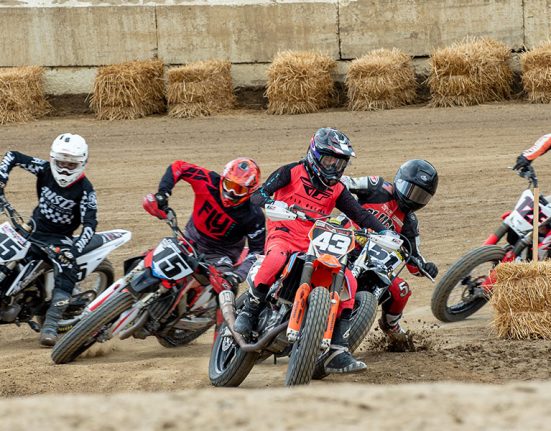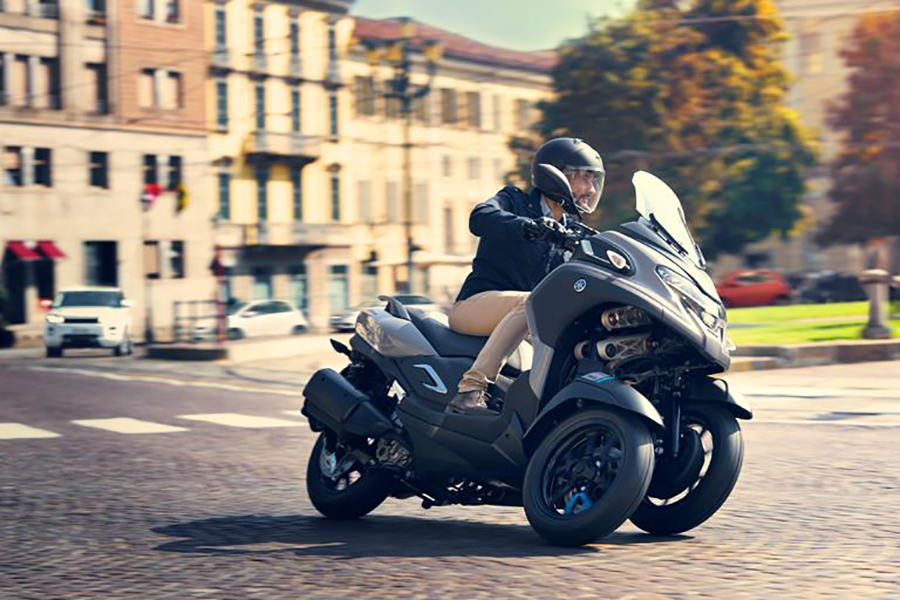The following is an industry press release …
Besides the already announced four world premiere models and two Japan premiere models, Yamaha Motor now also reveals two completely new world premiere models, the Tricity 300 and the MW-Vision concept, both displaying Yamaha’s Leaning Multi-Wheelers (LMW) technology.
The reveal of these two new models completes the 18 model line-up that is on display on the Yamaha booth that includes motorcycles, Leaning Multi-Wheelers (LMW), electric commuter vehicles, electrically power-assisted bicycles and an unmanned autonomous vehicle solution.
World Premiere Models – models making their world debut
Main Display Models
New Tricity 300. The Best Move in Town (reference vehicle)
New Yamaha 3-wheel model targets the premium Urban Mobility sector
Yamaha is one of the leading names in 3-wheel motorcycle technology, and the company is now ready to revitalise the Urban Mobility segment with the new Tricity 300, a premium multi-wheel model that brings a fresh new look to this important part of the European marketplace.
Drawing on the in-depth knowledge gained from the development and production of the Tricity 125 and NIKEN Leaning Multi Wheel (LMW) models, Yamaha’s designers have created a fashionable, modern and dynamic 3-wheel scooter that is targeted at the top end of the market. Based closely on the 3CT prototype that attracted huge interest when it first went on display in 2018, the Tricity 300 is ready to make a great impression in 2020 with its best-in-class specification, competitive price and unrivalled quality.
Tricity 300: Easy to ride and accessible to ‘B’ licence car drivers*
This new 3-wheel Urban Mobility scooter is equipped with a ‘BLUE CORE’ engine as well as a model-specific Leaning Multi Wheel steering linkage. The Tricity 300’s leaning front wheels give a natural and confident cornering character, and the high levels of traction offered by the two front wheels reinforce the feelings of stability, even on wet or slippery surfaces.
A key point about the new Tricity 300 is the fact that it may be ridden by customers with a full ‘B’ car licence * – making it one of the most accessible larger capacity Urban Mobility Yamaha models that has the potential to appeal to a whole new audience.
Featuring a sleek design, the Tricity 300 is aimed squarely at the top end of the Urban Mobility segment. In contrast to many current multi-wheel models, Yamaha anticipate that the majority of the demand will come from style and tech-conscious male urban commuters who are looking for an innovative, accessible and practical alternative to the car.
The Tricity 300 will be available Tech Kamo, Nimbus Grey and Matt Grey.
Full details about the new Tricity 300 will be announced at the EICMA Show in Milan, Italy on 4th November 11.30 hrs CET.
YAMAHA MW-VISION (reference vehicle)
This next-generation personal mobility concept model uses LMW* Technology and represents a proposal for a new relationship between users and their vehicles. It was developed with the aim of bringing people new Kando from the exhilaration of leaning as one with the machine through corners—enabled by the LMW platform—with greater comfort and peace of mind. It is also equipped with attitude control technology and reverse drive, and the cocoon-like vehicle body is easy to handle and maneuver. With approaches like interactive communication between the user and the vehicle through sound and light for all-new mobility experiences, the YAMAHA MW-VISION suggests how the fusion of robotics and mobility technologies can produce forms of mobility more in tune with human sensitivities.
Land Link Concept (special exhibit)
The Land Link Concept is an autonomous vehicle solution that moves freely across vast outdoor terrain by sensing its surroundings. The development concept was “Inter-Responsive Link.” AI-based image recognition allows it to decide its route independently and automatically avoid obstacles detected in the vehicle’s path. Each of the four wheels can be steered and driven independently, giving the model the ability to move in every direction. With its high mobility potential, it has the dexterity to work on tasks alongside us as a reliable partner.
E01 (reference vehicle)
This urban commuter model (power output comparable to a 125cc scooter engine) is fast-charge compatible and provides plenty of range, comfort and more when going from one area of the city to another. Combining Yamaha’s scooter and EV technologies, it brings practicality for everyday use as well as a quality ride exceeding that of conventional scooters. In addition to excellent comfort, it features a design that expressively highlights a new generation of sporty styling.
E02 (reference vehicle)
This E02 next-generation electric commuter bike (power output comparable to a 50cc scooter engine) was designed to be a great choice for personal mobility in cities. It features a compact, lightweight and easy-to-handle vehicle body and comes with an easily removable battery. With a focus on providing the smooth ride EVs are known for, it offers new value for electric mobility by adding even more fun and giving it a more familiar feel. The exterior design also visually accentuates the battery and electric motor comprising the powertrain, hinting at the light and agile ride it provides.
YPJ-YZ (reference vehicle)
YPJ-YZ e-Bike was designed with the looks of a race machine riding out on the track. Its mass-centralized chassis is suggestive of the engineering approach with our YZ Series of competition motocross models (locating chassis weight near the center for increased handling performance), with the down tube split in two to enclose the battery unit in a unique layout. The YPJ-YZ provides stable cornering performance and light handling even on rough terrain and the simple, lightweight frame was designed to show its relationship with YZ Series models. This e-Bike proposes a fun, stimulating and extra-ordinary riding experience and a new form of recreation for the future.
Japan Premiere Models: Models making their Japan debut
YZF-R1 (reference vehicle)
As Yamaha’s flagship supersport motorcycle, the latest YZF-R1 was designed and engineered with the performance to win on the racetrack under the concept of a “Full Control Evolution for the Master of the Racetrack.” While providing eco-friendliness meeting EU5 emission standards, the crossplane engine has been further refined and the model gains two more electronic rider aids: Engine Brake Management (EBM) and Brake Control (BC). Further development of various parts of the chassis take the model’s racetrack-focused performance to a new level.
Ténéré 700 (reference vehicle)
This adventure bike is powered by a 689cc liquid-cooled in-line 2-cylinder engine with a 270° crankshaft. It features a lightweight chassis providing the rider with plenty of freedom for riding posture, outstanding durability and serviceability, adaptability for carrying luggage and more, giving it a high-level balance of the respective traits wanted when riding off-road, adventure riding or touring. A variety of weight-reducing technologies have also made this model about 10 kg lighter than its XTZ660Z predecessor.
NIKEN GT (production vehicle)
Based on the 850cc NIKEN Leaning Multi-Wheel (LMW) model, which features both great cornering performance and onboard features for a quality cruising experience, this model provides additional comfort to further enhance its touring capabilities. Features to accomplish this include the large windscreen providing greater wind protection, heated grips for colder weather, a model-specific seat to reduce fatigue while on tour, a 12V DC power socket and center stand, all as standard equipment.
YZ450FX (reference vehicle)
Based on the high-end YZ450F competition motocross model, the YZ450FX offers the performance and functions desired in enduro races. Its settings are optimized for an enduro-spec racing machine, with light and agile handling, an engine tuned for good pull at high rpm and more. The machine used by Japan National Cross-Country (JNCC) competitor Kenji Suzuki will be on display.
TY-E (reference vehicle)
This electric trials bike is an advanced prototype and was created as part of Yamaha’s in-house technological R&D program. Its carbon fiber-reinforced plastic (CFRP) monocoque frame mounts a compact, high-rpm, high-output electric motor that delivers strong low-speed torque and smooth acceleration intended for conquering the obstacles in trials. Ridden by Kenichi Kuroyama in the FIM Trial-E Cup, the TY-E finished 2nd in the series in 2018 and 2019.
TRITOWN (reference vehicle)
The TRITOWN compact electric vehicle with twin front wheels is ridden standing up and utilizes Yamaha’s Leaning Multi-Wheel (LMW) mechanisms. The simple construction has the rider use their own sense of balance to control the vehicle, making short-range mobility a fun and exciting experience. The light, compact body and intuitive controls make it usable for a wide range of people. It is currently being field-tested at leisure facilities, parks and the like in Japan to ascertain its feasibility as a product, ability to attract customers, its competitiveness in the micromobility field, and more.
E-Vino (production vehicle)
Based on the popular retro-pop-styled Vino 50cc scooter, this electric commuter model offers a smooth ride that only an EV can provide. Its main features include the smooth feeling of acceleration, plenty of usable torque at very low speeds and an easily removable battery. It also has two running modes to suit riding conditions as well as a boost function to provide extra power for climbing up hills.
YPJ-XC (production vehicle)
This eMTB (electrically power-assisted mountain bike) uses Yamaha’s top-end PW-X drive unit and has a ride reflecting our DNA garnered in the e-Bike industry. The potent but controllable power-assist makes it a partner that can take you anywhere in the great outdoors to make weekend rides something special.
YNF-01 (special exhibit)
The YNF-01 low-speed mobility concept model is designed and engineered with off-road capability and styling aimed at inspiring a spirit of adventure in the user. The off-road-inspired design is complemented by the large tires and 4-wheel independent suspension that stimulate the user’s desire to “go everywhere and do everything.” It also won the Red Dot Award: Design Concept 2019 award.
JWX-1 PLUS+ (special exhibit)
This wheelchair electric drive unit makes it possible for users to convert the present manual wheelchair they are used to into an electric wheelchair simply by replacing the main wheels with the JWX-1 PLUS+. This adds the comfort of electric power to the ease of a manual wheelchair, greatly expanding a user’s range of mobility. It utilizes Yamaha’s proprietary JW Smart Core control system to control speed, rate of acceleration/deceleration, etc.
YMR-08 (special exhibit)
The YMR-08 industrial-use multi-rotor drone was developed with the concept of spraying one hectare of crops in 15 minutes. The coaxial contra-rotating rotors create strong downwash to send the agrichemicals down to the root area of the crops, achieving a spray quality and efficiency on par with our industrial-use unmanned helicopters. In recent years, use of drones like the YMR-08 to spray smaller fields that are difficult to cover with industrial-use unmanned helicopters has been on the rise.
FAZER R (special exhibit)
This top-end model of Yamaha’s industrial-use unmanned helicopters sees use in aerial agriculture for pest control, spraying fields with fertilizer and herbicides, etc. It boasts the largest agrichemical payload capacity in its class at 32 L and is capable of spraying 4 hectares of crops without replenishing agrichemicals or refueling. It also comes standard with Yamaha’s Turn Assist feature, which uses a combination of GPS and gyrosensors to calculate airspeed and distance to enable turns within a given radius over the spray area and fly at consistent lines and speeds for a uniform spray.






